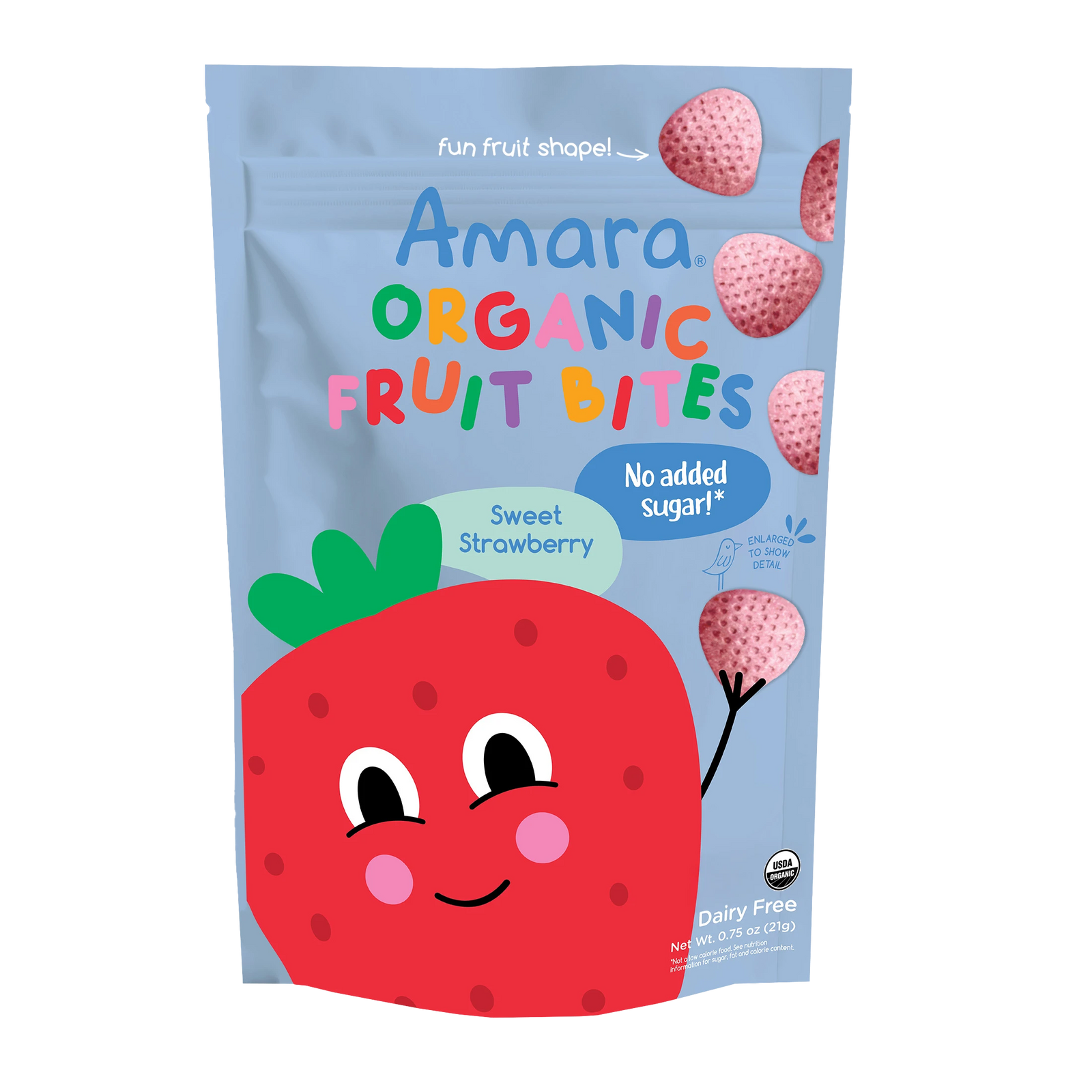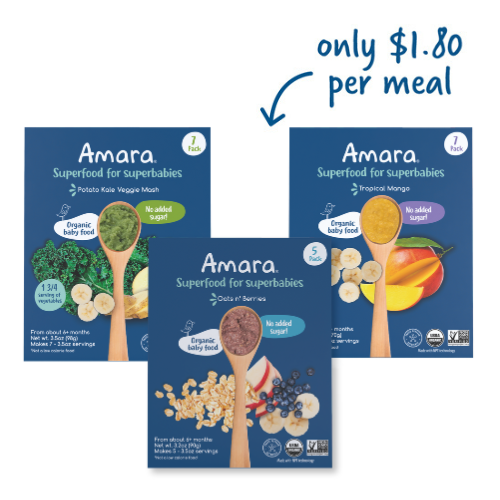Tips on How to Read a Baby Food Label
Baby Food Dictionary
There are few aisles of the supermarket that have more choices than baby food. Here’s your guide to understanding baby food and baby food labels and ingredients.
You’re a new mom, your baby is about 3 months old and you have just begun to get used to the sleepless nights, diaper changes and total life change that came to turn your life around (and your heart ❤️️) a few weeks ago. Now, you're starting to think about baby food. You’ve gone to your local supermarket and just stared and stared at the different kinds of baby foods available. Jars, pouches, canisters, so many different flavors, different things to take in. It’s overwhelming, right?
Here’s a baby food dictionary that can help you decipher the maze of baby food and what to feed your little one. We include quick tips on how to read the nutrition label on baby food - how to read the stages - and how to figure out the best food to feed your baby.
- Jars
- Pouches
- Formula
- Snacks
- Amara
Jars: Usually made of glass and have been around since our great grandparents. Pasteurized purees of fruits, vegetables, grains and sometimes meat. Use high repeat heat to keep the fruits and vegetables shelf stable. More about the process used here.
Squeeze Pouches: same content as the jars, just a different packaging. Yup, same high heat process, read more here.
Stages/ Months: Companies classify baby food into stages or months, helping parents to decide when to introduce the food to their little one. The World Health Organization and American Academy of Pediatrics recommend 6 months of exclusive breastfeeding and then the step by step introduction of complementary foods. In practice, studies show that a high percentage of mothers/parents/infants start introducing complementary foods earlier than 6 months. Whatever you decide is right for you and your family, make sure you check with your pediatrician.
The stages suggested in baby food offered on grocery shelves are usually decided by their ingredients and/or texture.
4-6 months or First stage: Complete puree with a single ingredient.
6-8 months or Second stage: “Strained”, a little chunkier than puree, and combination flavors.
8+ months or Third stage: “Mashed”, chunkier like mashed potatoes.
Note: Stages or months depend on what and when your little one is comfortable with different foods and textures, please consult your pediatrician for any specific questions or guidance.
Shelf Stable Puree:Vegetables and Fruits that have heated and grinded down to a puree for use in juices, baby food, soups, etc. Careful, as many of these purees include juice concentrate, which is concentrated fruit juice heated up and with a much higher sugar content. If you’ve ever tasted frozen juice concentrate, you know it’s like swallowing a spoonful of sugar. Now in a pouch, for your baby. Ek!
Ingredients:the list of ingredients are listed in order of the amount of each ingredient in the pouch from greatest to least. To gain insight, Sometimes you’ll see “apples” and sometimes you’ll see “apple puree”. There’s a difference. Here we talk a bit more about that pureed process.
Organic certification:In order to prove that food was raised or grown organically, third-party certifiers check to make sure food manufacturers follow organic regulations. Don’t just look for organic on the label. Look for certification seal as well!
Non-Gmo Seal: Non-GMO stands for non-genetically modified ingredients. Like organic food, this also needs third-party certification. Look for Non GMO Seal.
“Absorbic Acid”: Good old Vitamin C! Water-soluble vitamins found mainly in fruits, vegetables and potatoes, sensitive to heat, water and air. Food can be fortified with extra vitamin C after processing, since heat can destroy it. While it’s good to have in there, better to feed baby foods that keep the natural stuff in there.
“Citric Acid”: Often confused with vitamin C, but it’s not. This is the acid that gives the sour taste to lemons and limes, and is often used as a flavor enhancer. It occurs naturally mostly in citrus fruits, responsible for the sour taste of lemons and limes. Today citric acid is normally the product of a chemical synthesis and one of the most common food additives. Think of it as a flavor enhancer and as a preservative in food and beverages. However, it doesn’t improve nutrition. It can also be used to control pH.
Maltodextrin: is a polysaccharide, produced from starch (modified starch), easily digestible and used as food additive. The taste is moderately sweet to flavorless, used as a thickener and to increase energy content for example in foods for elderly people or in sport food products. You may also find it in baby formula as carbohydrates among other improving the solubility of the powder in water.
“No added sugar”: No added sugar can mean that the manufacturer didn’t add sugar, but also ask yourself the quality of the ingredients listed. How much natural sugar is in a puree from the concentrated processed fruits?
Pasteurization: High-heat process used to get rid of the bacteria, killing both the good, and the bad. More about the processhere.
Clear pouches: One of the big reasons why this was spurred was to help mom see mold inside of the pouch (high risk when pasteurizing). But it’s colorful...
Why is their fruit in every pouch? It has to do with controlling pH, which also controls mold and bacteria growth. One of the ways to control pH (how acid or basic something is) is to add fruit that swings pH enough to slow the growth of any bacteria inside. It’s a natural way to keep food fresher.
Daily Values: Recommended daily amounts of nutrients based on age. These are calculated by the Food and Drug Administration. The latest figures can be found at this link.
DHA (docosahexaenoic acid) is a fatty acid found in the meat of cold-water fish, including mackerel, herring, tuna, halibut, salmon, cod liver, whale blubber, and seal blubber. An adequate intake of this omega-3 fatty acid during pregnancy is essential for the health and development of the child. If a mother does not like to eat fish or does not have the habit of regular fish consumption, she should evaluate the intake of DHA supplement during pregnancy with her physician.
Iron: A vital nutrient for the blood. Lack of iron is a common nutritional deficiency. It’s also one that can cause complications during pregnancy. Fortunately, iron supplementation is easy and iron is present in a lot of healthy foods. Ask your doctor to check your iron levels to see how much you need to take.
We hope this helps to understand some of the common terms around baby food and reading a baby food label. At Amara, we believe that you - and your baby - shouldn't have to choose between nutrition and convenience.That's why we started Amara baby food - to bring you all the benefits of homemade - without starting from scratch. Just add breast milk, formula or water for a gentle transition to solid foods and your baby's nutritious meal is ready in seconds.
Not sure where to start?We have an Introduction to Solids pack that's perfect to start your baby on solid foods or you can shop our whole collection of baby food blends: vegetable forward flavors, plant based proteins, baby cereals and superfruits - always 100% organic. Use the code ONLYTHEBEST for 15% off and free shipping on your first order of Amara.
We know it can be overwhelming but we're here for you. Your pediatrician and your mommy tribe can help you as well as our on staff PHD in nutrition. Have more questions? Follow along our food fact fridays every week on our Instagram or send us your questions and we’ll keep debunking those baby food myths!
xoxo







Leave A Comment